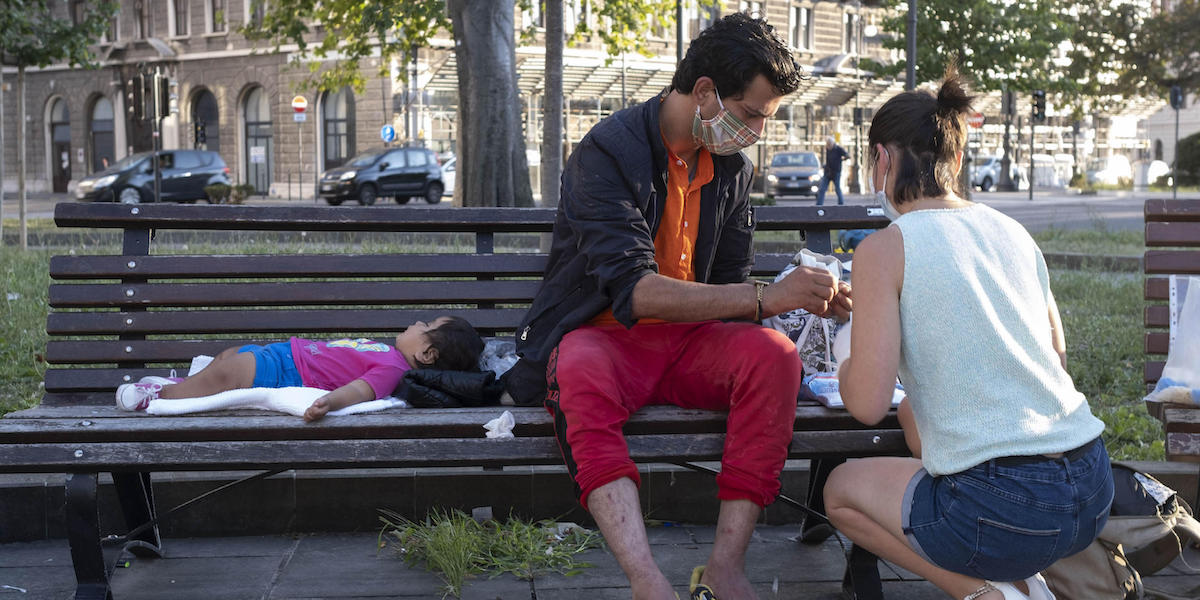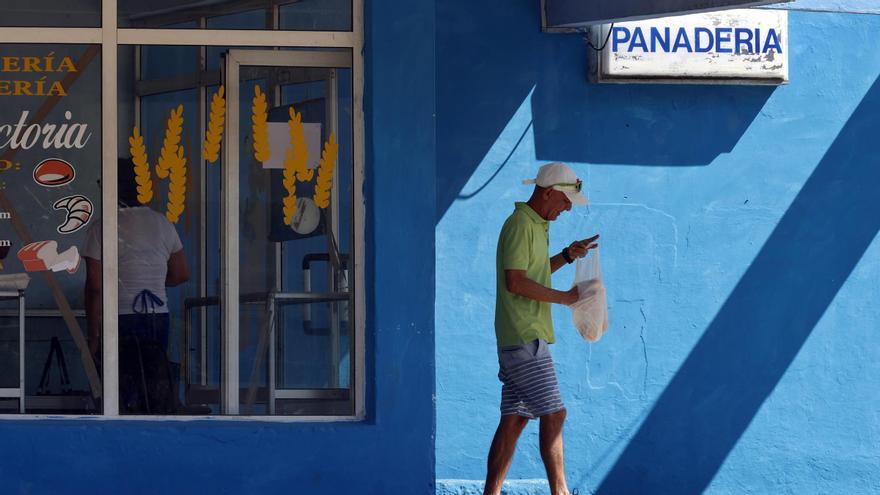Volunteers from the Linea d’Ombra association help migrants arriving in Trieste via the Balkan route, August 2020 (ANSA/MAURO DONATO)
It is the access point for the Balkan Route, but there are too many migrants compared to the carrying capacity and hundreds of people have no place to stay.
For several months, the city of Trieste, in Friuli Venezia Giulia, has had difficulty managing the ever-increasing number of migrants: the places made available by the national reception system have long run out, and even many of the associations active in the area are unable to do so. To guarantee a place to stay for all arriving persons, including minors. They are the migrants who reach Italy and Europe via the so-called Balkan Route, a long and hostile route that starts in Asia and passes overland through Greece, Albania, then Croatia and Slovenia to arrive directly at Trieste, an increasingly crowded crossroads and the beginning of the route. Refers to other European countries.
From January to July 2023, 7,890 people arrived in Trieste via the Balkan route. These numbers cannot be compared to the numbers of arrivals by sea (in the same period). They landed Nearly 90 thousand people), but there is still a sharp increase compared to previous years: in the first seven months of 2022 They have arrived Just over 3 thousand people. Arrivals also increased during the winter months, when the route is usually less crowded, mainly due to the cold: between January and March 2023, 2,051 people arrived in Trieste, more than five times the 370 registered in the same period in 2022.
The situation quickly became difficult to manage, and this summer nearly 500 people returning after months of walking were forced to sleep on the streets. Thanks to word of mouth, many gathered in the Silos, a kind of large abandoned warehouse next to the city’s main train station. The conditions in the silos are not at all comfortable, also because there is almost nothing inside. There is no electricity, running water, or bathrooms, and people sleep on the ground in sleeping bags or on makeshift mattresses. When it rains, water comes in, and waste accumulates, as no one comes to clean it or collect garbage.
“It’s a hellish cycle,” says Corrado Mandrioli, a ResQ activist.. The association was set up to help migrants trying to reach Italy and Europe by sea, but in recent months it has also opened an office in Trieste to handle the initial reception of arrivals from the Balkan route. “First time I went [al Silos] To distribute clean clothes, everyone asked me to wear tight trousers at the ankles, to prevent mice from entering: this is the level.”
The silos of Trieste in 2020 (ANSA/MAURO DONATO)
Most of the migrants arriving in Trieste are between twenty and thirty years old, and almost all of them are male: the Balkan route is risky, even physically, which is why women and families with children arrive, says Mandrioli. In rare clouds. The boys and men then leave alone or in small groups, from Bangladesh, Pakistan or Syria and cross many other countries, from Afghanistan to Turkey and Greece, arriving in the Balkans. They then continue their way through the corridor that runs between Bulgaria, Romania, Slovenia and Croatia and eventually reaches Italy.
On average, the journey takes a few months, but each experience is subjective: “Those who do have alternative sections on foot with bus trips,” says Mandrioli, explaining that migrants often travel part of the journey and then stop to do temporary work to earn the money needed to keep going. . Knowledge of languages and availability of economic resources are key, but on such a long journey, luck is also a factor that should not be underestimated.
“They arrive with worn-out clothes. The first thing we do is give them a chance to wash and change clothes, then we check their health condition. “Many people suffer from foot injuries or tendonitis, which are ailments related to walking,” Mandrioli says. After legal assistance and filling out the asylum application, comes the problem of residency. According to data from the National System of Reception and Integration (SAI), in August 2023 in Friuli Venezia Giulia They were available 268 places for immigrants divided into six structures. Especially in Trieste, much of the system is also based on a large-scale reception model, through which migrants are housed in standard apartments: those available in 2022 She was More than 180.
– Read also: Municipalities no longer provide places for unaccompanied migrant minors
For many years, the reception system has been working satisfactorily, especially thanks to transfers. “Trieste is a station on the Balkan Route, and it is not possible for all people who arrive to stay here, otherwise a large number of places would be needed compared to the characteristics of the region,” says Gianfranco Schiavone, president of the Italian company. Solidarity Consortium (ICS) and member of ASGI, Association for Legal Studies on Migration. “Part of the immigrants are absorbed in Trieste, but the rest must be transported” to other cities.
But starting at the end of 2022, the intensification of arrivals has put the reception system in crisis throughout Italy. According to data from the Ministry of Interior, from January 1 to September 12 They landed More than 118,000 people, nearly double the 65,000 people who arrived in 2022 and three times as many as in 2021. In recent months, reception facilities across the country have filled up rapidly, and the transportation mechanism on which Trieste relied has ground to a halt.
According to Schiavone, “since the summer of 2022, the system no longer works,” especially since “the Ministry of the Interior began to give a completely insufficient number of quotas for resettlement operations, creating the phenomenon of asylum seekers on the street, who had never been to Trieste.” ” In this way, the government implicitly encourages migrants to leave Italy and move to other countries irregularly, since according to the European rules of the Dublin Treaty, the country of first arrival must be responsible for reception practices.
And fact However, for many migrants from Eastern Europe, Trieste is just another transit point. In fact, most of them do not want to stay in Italy and aim to reach other European countries where they perhaps already have a network of contacts they can rely on, in Germany, France or Scandinavia.
In Trieste, the Italian Solidarity Union, headed by Schiavone, coordinates the work of several associations that help migrants. Many of the initial reception activities take place in Piazza della Libertà, in front of the train station, in the evening. From 6pm to midnight, food and clothing are distributed, while from 9am to 7pm the “day center” is always active, a structure where migrants can take shelter, go to the bathroom, charge their cell phones, talk to someone and undergo… Some medical tests. Despite the general difficulties faced by the reception system, in the city activists and associations are moving to help immigrants get to know each other and cooperate with a certain efficiency: “They are people who help each other and cooperate, in a very beautiful human atmosphere.” “Mandrioli says.
Another essential part of the reception system is medical care, which is essential but also more difficult to ensure, since it requires a trained and specialized workforce. DonK Humanidance Medicine (DonK HM) is a voluntary association from Trieste that provides free health care to those who cannot access treatment, including asylum seekers who often find themselves having to wait months to obtain the health card necessary to access the national service.
In 2022, volunteer doctors at DonK HM made more than 3 thousand visits, but now the pace is increasing significantly. According to Stefano Bardari, president of the association, the diseases that migrants most often suffer from, such as scabies, can be easily solved with targeted treatments and are now considered commonplace in all hospitals. However, the conditions in which these people are forced to live often complicate the situation and make diseases last longer or worsen more than necessary. In addition to the physical problems resulting from the journey, many migrants also suffer from mental disorders: “But who in his condition cannot get it?” Papyrus asks.
According to associations active in the region, the return of the reception system in Trieste to functioning properly will require more support from local and national public bodies. Currently, both the municipality and the region are governed by the oath: the mayor of the city is Roberto Dipiazza, from Forza Italia, while the president of Friuli Venezia Giulia is Northern League member Massimiliano Fedriga. “With more structure and proper operation of the transport operations, the situation will be completely under control,” says Mandrioli.
Dipiazza was mayor of Trieste from 2001 to 2011, and then again from 2016. “I have been working on the Balkan route for twenty years: just as Lampedusa entered into a crisis, we are also in a crisis today,” he says. According to DiPiazza, the widespread reception turned out to be a “failure.” To at least partially solve the problem, the municipality proposes to house the migrants in the many empty barracks in the area. But this requires government intervention, which has not yet happened.
The region is instead proposing a different, more radical approach: “There is a fundamental mistake we are still making: treating Friuli-Venezia Giulia as if it were the first point of entry into the European Union,” says the regional advisor for security and migration. , Pierpaolo Roberti. In fact, before arriving in Italy, migrants crossing the Balkan route always pass through Slovenia, which is part of European Free Movement Area (Schengen Area)From Croatia, which is also a member state of the European Union. Therefore, according to Roberti, the practical and administrative responsibilities related to the reception should not fall exclusively on Italy. “There is no suitable candidate and, objectively, there is a lack of controls at other borders,” he says.
It is the dynamics of so-called “secondary movements” by which migrants entering the EU do not stop in the country of first arrival, but rather continue irregularly towards their final destination. This also often happens in Italy, which is the first point of entry into the EU for many migrants who then seek asylum in France, Germany or other European countries. Even if international rules do not allow this, the government often does nothing to prevent these movements, since the national system is already struggling to take care of migrants who voluntarily decide to stay in Italy and initiate bureaucratic procedures here.
However, Italy’s neighboring countries have recently registered a significant increase in the number of arrivals and, consequently, in asylum applications. Croatian Interior Minister Davor Bozinovic He said Orders in 2023 increased by 700 percent compared to the previous year, while in the first eight months of the year Slovenia to stop 36,000 immigrants tried to cross the border illegally, including 34,000 who came from Croatia. different in recent years Journalistic investigations Reports by humanitarian organizations showed numerous cases of torture, ill-treatment and violence against migrants trying to cross the Greek and Bosnian borders, among other things.
Moreover, according to Roberti, the government should also open one or more hotspots in Friuli Venezia Giulia, that is, the first reception centers where migrants are identified and registered, two necessary steps to then be able to organize a possible relocation. Today, there are only four active hotspots in Italy, all in the south: in Lampedusa, Pozzallo (in the province of Ragusa), Messina, and Taranto.

“Freelance social media evangelist. Organizer. Certified student. Music maven.”



